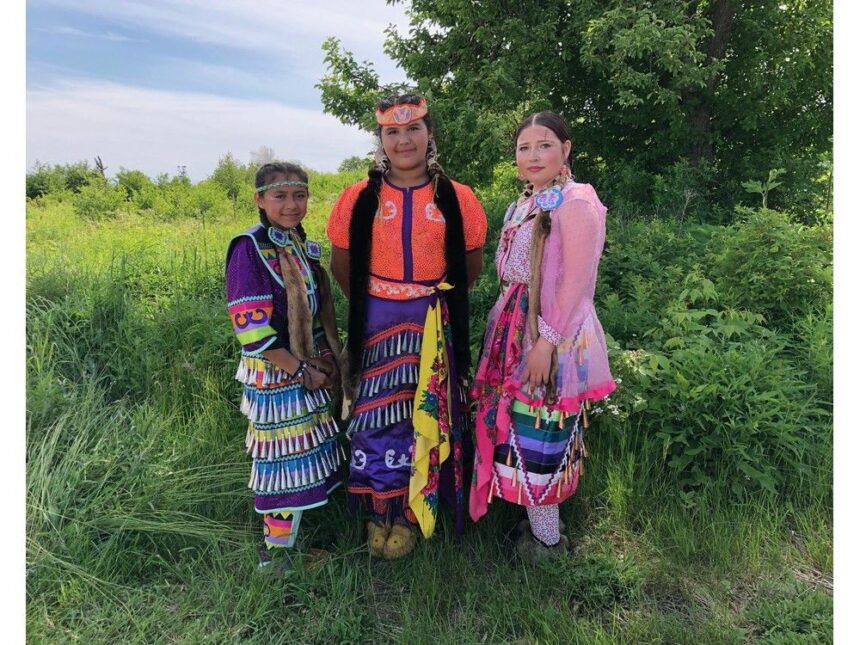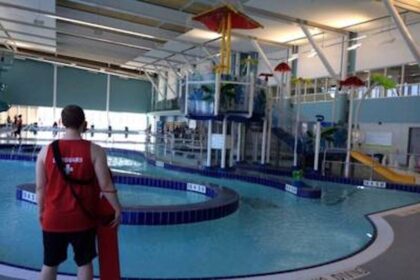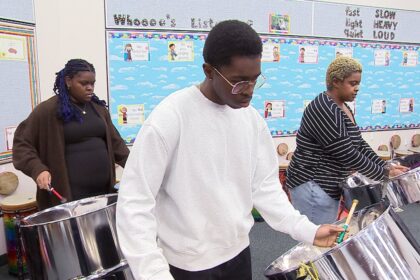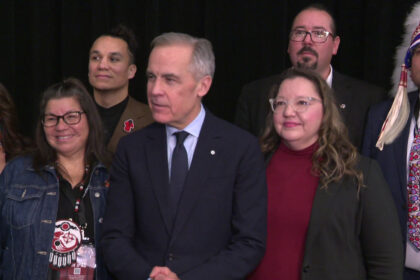Jingle dancing is popular with pre-teen and teenage young women at Mi’kmaq powwows. Above, attending last weekend’s Eskasoni Powwow were from left: Kallia Augustine, 12, Elsipogtog; Arenna Augustine, 11, Tobique First Nation; and Kyra George, 12, Chapel Island. The women wear pretty skirts adorned with metal cones sewn on that make a distinctive sound whenever they move. The sound is similar to that of melodic rain. The dance is often associated with healing and is performed at powwows and other ceremonies. Photo by Rosemary Godin /Cape Breton PostArticle contentWith a powerful message to all First Nation’s people who attended the 34th annual Eskasoni Powwow Saturday afternoon, announcer Donnie Speidel opened the event by telling the people: “We are the answer to our grandmother’s prayers.” THIS CONTENT IS RESERVED FOR SUBSCRIBERS ONLY.Subscribe now to access this story and more:Unlimited access to the website and appExclusive access to premium content, newsletters and podcastsFull access to the e-Edition app, an electronic replica of the print edition that you can share, download and comment onEnjoy insights and behind-the-scenes analysis from our award-winning journalistsSupport local journalists and the next generation of journalistsSUBSCRIBE TO UNLOCK MORE ARTICLES.Subscribe or sign in to your account to continue your reading experience.Unlimited access to the website and appExclusive access to premium content, newsletters and podcastsFull access to the e-Edition app, an electronic replica of the print edition that you can share, download and comment onEnjoy insights and behind-the-scenes analysis from our award-winning journalistsSupport local journalists and the next generation of journalistsRegister to unlock more articles.Create an account or sign in to continue your reading experience.Access additional stories every monthShare your thoughts and join the conversation in our commenting communityGet email updates from your favourite authorsSign In or Create an AccountorArticle contentArticle contentEskasoni First Nation Chief Leroy Denny welcomed people who had come from near and far. He told everyone that they were welcome and mentioned many of the places the Mi’kmaq dancers had travelled from. Article contentArticle contentHe introduced elder Regina Doucette and invited her to say a prayer. She acknowledged relatives who had overcome troubled times and the cultural genocide of Indigenous people in this country. Article contentAnd then, the colourful, graceful and skilled dancing of Mi’kmaq people of all ages took place. It began with an exciting Grass Dance by young warriors who symbolically prepared the ground for the grand entry and later dance events. Article content Little Thunder Bear Sylliboy, 15, of the Millbrook First Nation was dancing in the Teen Grass Dancer class on Saturday at the Eskasoni Powwow. Sylliboy said this was his first time in the Eskasoni Powwow, but he has danced in others. Grass dancing traditionally begins the powwow as a symbolic and traditional way of both blessing the ground others will dance on and pounding down the grass to make it easier for the dancers. Photo by Rosemary Godin /Cape Breton PostArticle contentOne of the dancers, Little Thunder Bear Sylliboy from Millbrook, said the grass dance is a way to bless the ground and prepare it to be ready for celebration. Traditionally, it is a way young men trampled the long grasses before any celebration or gathering and made the area ready for dancing or meeting. Article contentEvery regalia we wear is a healing regalia. – Kyra George, Chapel IslandArticle contentThe 15-year-old had come from Millbrook First Nation to compete in the Teen Grass Dancing class. Article content Leading the grand entry on Saturday at Eskasoni’s 34th annual powwow was Donald Morrison who carried the Eagle Staff. He was followed by local RCMP officers as well as dancers in all the age and dance classes who performed in front of a large crowd under clear skies. The three-day celebration attracted visitors and participants from many Canadian provinces and a few from the United States. The Mi’kmaq Nation includes all Atlantic provinces, the Gaspe Peninsula in Quebec, as well as Indigenous people in the northeastern region of Maine. Photo by Rosemary Godin /Cape Breton PostArticle contentThe powwow is an annual celebration of Mi’kmaq culture, featuring dancing, singing, and traditional arts and crafts. Article contentArticle contentChapel Island’s Kyra George competed in the Jingle Dance class for ages 6-12 years. The 12-year-old said she likes to meet the people who come from all over. She also recognized the importance of annual powwow events. Article contentArticle content“Our elders and ancestors couldn’t dance, because they went to residential schools,” she said. “Our learning, our dancing – it was all taken away from us.Article content“Every regalia we wear is a healing regalia.” Article contentThe Eskasoni community holds the first powwow on Cape Breton every year and also one of the largest Mawio’mi events (powwows) in Eastern Canada. The next powwow on Cape Breton will be in Potlotek First Nation on July 19-20, followed by Membertou on Aug. 1-3; We’koqma’k on Aug. 30-31; and Wagmatcook on Oct. 18-19. Article content Peter Watson of Metepenagiag (Red Bank) in New Brunswick was one of many dancers who thrilled the crowd with their dancing and their colourful regalia. He has participated in many powwows around Mi’kma’ki every season. The Eskasoni Powwow is a favourite place for many skilled Mi’kmaq dancers to come for the community, the food, the dancing and the hospitality. Photo by Rosemary Godin /Cape Breton PostArticle content Muwin Dana travelled a long way to dance at the 2025 Eskasoni Powwow over the weekend. Dana is a dancer from Indian Township, Maine. He was one of several young men known as grass dancers who prepare the ground for dancing by trampling down the tall grasses of a field or prairie. The regalia they wear often includes long strands of yarn that represent grass swaying in the wind as the dancer makes many circular movements. Photo by Rosemary Godin /Cape Breton PostArticle content Eleven-year-old Jaxson Papatie was a stand-out in his blue regalia when he and his father travelled to the Eskasoni Powwow over the weekend all the way from Barriere Lake (Anishanabe) in Quebec. Jaxson was dancing in the Junior Boys class. This was their first time in Cape Breton and they said the hospitality they found at Eskasoni was fabulous. Photo by Rosemary Godin /Cape Breton PostArticle content Young people were well-represented in the dance competitions on Saturday afternoon. Taryn Levi, 9, Elsipogtog First Nation and Xander Pictou, 10, from Red Bank (Metepenagiag Mi’kmaq Nation), are good friends who both danced in the Junior Boys class. Both live in New Brunswick but only get to see each other at powwows around Mi’kma’ki. Photo by Rosemary Godin /Cape Breton PostArticle content Traditional grass dancers opened Saturday afternoon’s 34th annual Eskasoni Powwow over the weekend. The grass dancer’s role is to prepare the ground for the grand entry of leaders and dancers at Indigenous celebrations. The movements of the dancers are graceful and strong, imitating swaying, long grasses found in the prairies and marshy areas. Photo by Rosemary Godin /Cape Breton PostArticle content The grand entry at Saturday’s 34th annual Eskasoni Powwow included dancers from all dance classes. A few of the jingle dancers made their way around the powwow grounds delighting the crowd with pretty regalia and the melodic rainfall sound of the metal cones sewn to their dresses. Photo by Rosemary Godin /Cape Breton PostArticle content Todd Evans, a dancer from Newfoundland, wasn’t competing in any classes, but said he loves to dance and attends many powwows whenever he can. The 34th annual Eskasoni Powwow attracted dancers and participants from both Canada and the United States. People came from Maine, Quebec, Ontario and all the Maritime provinces. Photo by Rosemary Godin /Cape Breton PostArticle content Several drum groups gathered in a tent beside the Eskasoni Powwow grounds Saturday to play the music for the dancers. Above, drummers from the Wabanaki Confederacy in Elsipogtog, N.B., were invited drums and performed several times during the powwow. Photo by Rosemary Godin /Cape Breton PostArticle content Mikmaw elder, Korean War vet, and traditional dancer, Al Oakley, 92, stood and held an eagle feather high in the air as the 50+ male dancer class took to the field at the Eskasoni Powwow on Saturday. Oakley, who is from Wampanoag Nation, has lived in Eskasoni for the last 40 years. Oakley, an accomplished dancer himself, said he couldn’t dance with the men this year due to health, and so held a feather to the sky as a sign of respect to them and to show the dancers he is with them. Photo by Rosemary Godin /Cape Breton PostArticle content
IN PHOTOS: Eskasoni Powwow draws crowds from near and far











